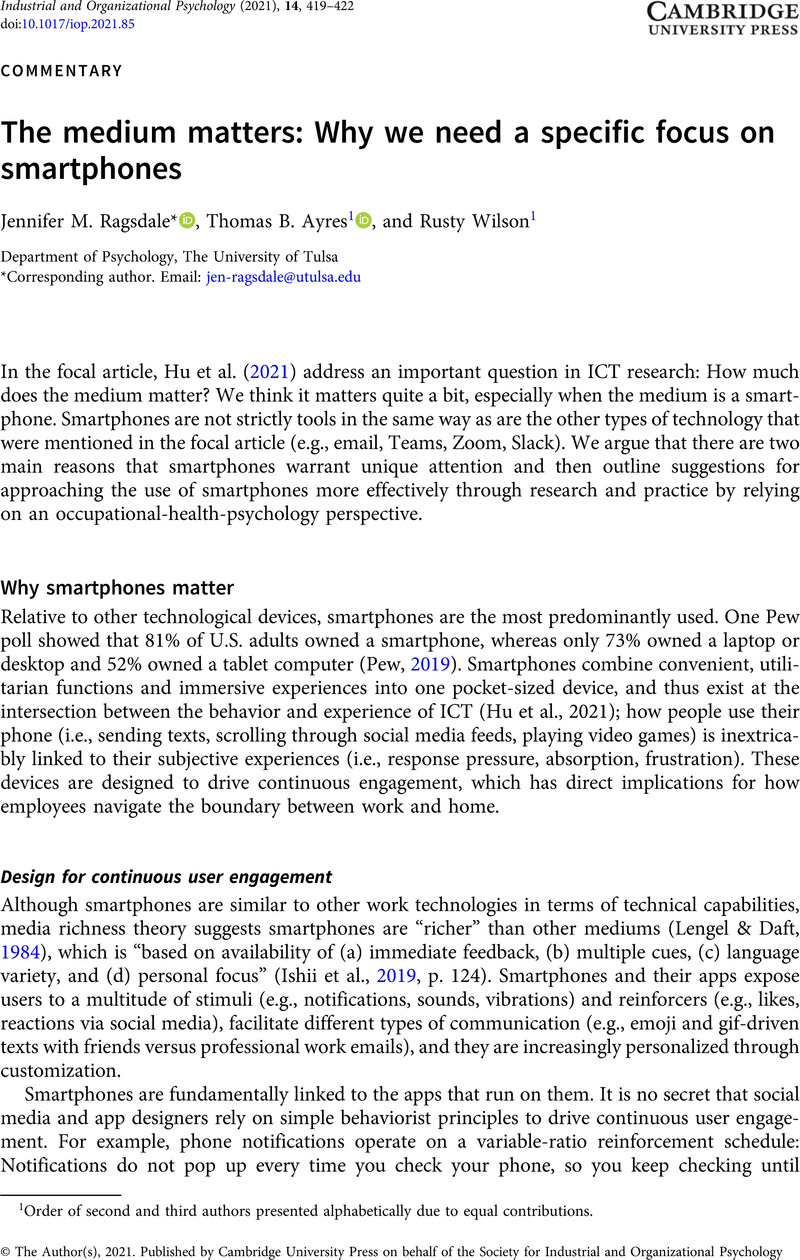No CrossRef data available.
Article contents
The medium matters: Why we need a specific focus on smartphones
Published online by Cambridge University Press: 22 September 2021
Abstract
An abstract is not available for this content so a preview has been provided. Please use the Get access link above for information on how to access this content.

- Type
- Commentaries
- Information
- Copyright
- © The Author(s), 2021. Published by Cambridge University Press on behalf of the Society for Industrial and Organizational Psychology
Footnotes
1
Order of second and third authors presented alphabetically due to equal contributions.
References
Bakker, A. B., & Rickard, N. (2018). Engagement in mobile phone app for self-monitoring of emotional wellbeing predicts changes in mental health: MoodPrism. Journal of Affective Disorders, 227, 432–442. https://doi.org/10.1016/j.jad.2017.11.016
CrossRefGoogle ScholarPubMed
Brosschot, J. F., Pieper, S., & Thayer, J. F. (2005). Expanding stress theory: Prolonged activation and perseverative cognition. Psychoneuroendocrinology, 30(10), 1043–1049.CrossRefGoogle ScholarPubMed
Derks, D., & Bakker, A. B. (2014). Smartphone use, work–home interference, and burnout: A diary study on the role of recovery. Applied Psychology: An International Review, 63(3), 411–440.CrossRefGoogle Scholar
Derks, D., ten Brummelhuis, L. L., Zecic, D., & Bakker, A. B. (2014). Switching on and off: Does smartphone use obstruct the possibility to engage in recovery activities? European Journal of Work and Organizational Psychology, 23(1), 80–90.CrossRefGoogle Scholar
Hu, X., Barber, L., Park, Y., & Day, A. (2021). Defrag and reboot? Consolidating information and communication technology research in I-O psychology. Industrial and Organizational Psychology: Perspectives on Science and Practice, 14(3), 371–396.Google Scholar
Ishii, K., Lyons, M. M., & Carr, S. A. (2019). Revisiting media richness theory for today and future. Emerging Technologies: Perspectives from Behavioral Scientists, 1(2), 124–131.CrossRefGoogle Scholar
Lengel, R. H., & Daft, R. L. (1984). An exploratory analysis of the relationship between media richness and managerial information processing. Defense Technical Information Center. https://apps.dtic.mil/sti/citations/ADA143503
Google Scholar
Quick, J. C., Wright, T. A., Adkins, J. A., Nelson, D. L., & Quick, J. D. (2013). Preventive Stress Management in Organizations. American Psychological Association.CrossRefGoogle Scholar
Ragsdale, J. M., & Hoover, C. S. (2016). Cell phones during nonwork time: A source of job demands and resources. Computers in Human Behavior, 57, 54–60. https://doi.org/10.1016/j.chb.2015.12.017
CrossRefGoogle Scholar
Secunda, Paul M. (2019) The employee right to disconnect. Notre Dame Journal of International & Comparative Law, 9(1), Article 3.Google Scholar
Statista. (2020, September 2). Number of smartphones sold to end users worldwide from 2007 to 2021 (in millions of units). https://www.statista.com/statistics/263437/global-smartphone-sales-to-end-users-since-2007/
Google Scholar
Terry, W. S. (2015). Learning and memory: Basic principles, processes, and procedures (4th ed.). Pearson.CrossRefGoogle Scholar
The Pew Research Center. (June, 2019). Mobile fact sheet. https://www.pewresearch.org/internet/fact-sheet/mobile/
Google Scholar


